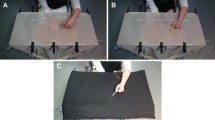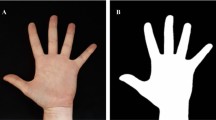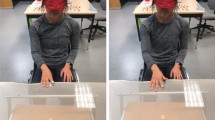Abstract
Perceiving the external spatial location of body parts using position sense requires that immediate proprioceptive afferent signals be integrated with information about body size and shape. Longo and Haggard (Proc Natl Acad Sci 107:11727–11732, 2010) developed a method to measure perceptual hand maps reflecting this metric information about body size and shape. In this paradigm, participants indicate the perceived location of landmarks on their occluded hand by pointing with a long baton held in their other hand. By comparing the relative location of judgments of different hand landmarks, perceptual hand maps can be constructed and compared to actual hand structure. The maps show large and highly stereotyped distortions. Here, I investigated the potential effect of biases related to active motor control of the hand doing the pointing in these distortions. Participants localized the fingertip and knuckle of each finger on their occluded left hand either by actively pointing with a baton held in their right hand (pointing condition) or by giving verbal commands to an experimenter on how to move the baton (verbal condition). Similar distortions were clearly apparent in both conditions, suggesting that they are not an artifact of motor control biases related to the pointing hand.



Similar content being viewed by others
References
Adams DC (1999) Methods for shape analysis of landmark data from articulated structures. Evol Ecol Res 1:959–970
Aglioti S, DeSouza JF, Goodale MA (1995) Size-contrast illusions deceive the eye but not the hand. Curr Biol 5:679–685
Ambroziak KB, Tamè L, Longo MR (2018) Conceptual distortions of hand structure are robust to changes in stimulus information. Conscious Cogn 61:107–116
Anema HA, van Zandvoort MJE, de Haan EHF, Kappelle LJ, de Kort PL, Jansen BPW et al (2009) A double dissociation between somatosensory processing for perception and action. Neuropsychologia 47:1615–1620
Azañón E, Tamè L, Maravita A, Linkenauger SA, Tajadura-Jiménez A, Longo MR (2016) Multimodal contributions to body representation. Multisens Res 29:635–661
Bookstein FL (1991) Morphometric tools for landmark data: geometry and biology. Cambridge University Press, Cambridge
Burgess PR, Wei JY, Clark FJ, Simon J (1982) Signaling of kinaesthetic information by peripheral sensory receptors. Ann Rev Neurosci 5:171–187
Cardinali L, Brozzoli C, Urquizar C, Salemme R, Roy AC, Farnè A (2011) When action is not enough: tool-use reveals tactile-dependent access to body schema. Neuropsychologia 49:3750–3757
Carey DP, Dijkerman HC, Murphy KJ, Goodale MA, Milner AD (2006) Pointing to places and spaces in a patient with visual form agnosia. Neuropsychologia 44:1584–1594
Cocchini G, Galligan T, Mora L, Kuhn G (2018) The magic hand: plasticity of mental hand representation. Quart J Exp Psychol. https://doi.org/10.1177/1747021817741606
Coelho LA, Gonzalez CLR (2018) The visual and haptic contributions to hand perception. Psychol Res. https://doi.org/10.1007/s00426-017-0870-x
Coelho LA, Zaninelli G, Gonzalez CLR (2017) A kinematic examination of hand perception. Psychol Res 81:1224–1231
Collins DF, Refshauge KM, Todd G, Gandevia SC (2005) Cutaneous receptors contribute to kinesthesia at the index finger, elbow and knee. J Neurophysiol 94:1699–1706
Edin BB, Johansson N (1995) Skin strain patters provide kinaesthetic information to the human central nervous system. J Physiol 487:243–251
Ferrè ER, Vagnoni E, Haggard P (2012) Vestibular contributions to bodily awareness. Neuropsychologia 51:1445–1452
Ferrell WR, Gandevia SC, McCloskey DI (1987) The role of joint receptors in human kinaesthesia when intramuscular receptors cannot contribute. J Physiol 386:63–71
Ganea N, Longo MR (2017) Projecting the self outside the body: body representations underlying proprioceptive imagery. Cognition 162:41–47
Goodale MA, Milner AD, Jakobson LS, Carey DP (1991) A neurological dissociation between perceiving objects and grasping them. Nature 349:154–156
Goodwin GM, McCloskey DI, Matthews PBC (1972) The contribution of muscle afferents to kinaesthesia shown by vibration induced illusions of movement and by the effects of paralysing joint afferents. Brain 95:705–748
Jones SA, Cressman EK, Henriques DY (2010) Proprioceptive localization of the left and right hands. Exp Brain Res 204:373–383
Jones SA, Fiehler K, Henriques DY (2012) A task-dependent effect of memory and hand-target on proprioceptive localization. Neuropsychologia 50:1462–1470
Kammers MPM, de Vignemont F, Verhagen L, Dijkerman HC (2009) The rubber hand illusion in action. Neuropsychologia 47:204–211
Longo MR (2014) The effects of immediate vision on implicit hand maps. Exp Brain Res 232:1241–1247
Longo MR (2015a) Posture modulates implicit hand maps. Conscious Cogn 36:96–102
Longo MR (2015b) Intuitive anatomy: distortions of conceptual knowledge of hand structure. Cognition 142:230–235
Longo MR (2015c) Implicit and explicit body representations. Euro Psychol 20:6–15
Longo MR (2017a) Distorted body representations in healthy cognition. Quart J Exp Psychol 70:378–388
Longo MR (2017b) Expansion of perceptual body maps near—but not across—the wrist. Front Hum Neurosci 11:111
Longo MR, Haggard P (2010) An implicit body representation underlying human position sense. Proc Natl Acad Sci 107:11727–11732
Longo MR, Haggard P (2012a) A 2.5-D representation of the human hand. J Exp Psychol Hum Percept Perform 38:9–13
Longo MR, Haggard P (2012b) Implicit body representations and the conscious body image. Acta Psychol 141:164–168
Longo MR, Morcom R (2016) No correlation between distorted body representations underlying tactile distance perception and position sense. Front Hum Neurosci 10:593
Longo MR, Azañón E, Haggard P (2010) More than skin deep: body representation beyond primary somatosensory cortex. Neuropsychologia 48:655–668
Longo MR, Long C, Haggard P (2012) Mapping the invisible hand: a body model of a phantom limb. Psychol Sci 23:740–742
Longo MR, Mancini F, Haggard P (2015a) Implicit body representations and tactile spatial remapping. Acta Psychol 160:77–87
Longo MR, Mattioni S, Ganea N (2015b) Perceptual and conceptual distortions of implicit hand maps. Front Hum Neurosci 9:656
Lopez C, Schreyer H-M, Preuss N, Mast FW (2012) Vestibular stimulation modifies the body schema. Neuropsychologia 50:1830–1837
Macefield G, Gandevia SC, Burke D (1990) Perceptual responses to microstimulation of single afferents innervating joints, muscles and skin of the human hand. J Physiol 429:113–129
Matthews PBC (1972) The mammalian muscle receptors and their central actions. Edward Arnold, London
Mattioni S, Longo MR (2014) The effects of verbal cueing on implicit hand maps. Acta Psychol 153:60–65
Medina J, Duckett C (2017) Domain-general biases in spatial localization: evidence against a distorted body model hypothesis. J Exp Psychol Hum Percept Perform 43:1430–1443
Milner AD, Goodale MA (1995) The visual brain in action. Oxford University Press, Oxford
Napier J (1980) Hands. Princeton University Press, Princeton
Oldfield RC (1971) The assessment and analysis of handedness: the Edinburgh inventory. Neuropsychologia 9:97–113
Paillard J, Michel F, Stelmach G (1983) Localization without content: a tactile analogue of ‘blindsight’. Ann Neurol 40:548–551
Pavani F, Boscagli I, Benvenuti F, Rabuffetti M, Farnè A (1999) Are perception and action affected differently by the Titchner circles illusion? Exp Brain Res 127:95–101
Pisella L, Binkofski F, Lasek K, Toni I, Rossetti Y (2006) No double-dissociation between optic ataxia and visual agnosia: multiple sub-streams for multiple visuo-manual integrations. Neuropsychologia 44:2734–2748
Proske U, Gandevia SC (2009) The kinaesthetic senses. J Physiol 587:4139–4146
Proske U, Gandevia SC (2012) The proprioceptive senses: their roles in signaling body shape, body position and movement, and muscle force. Physiol Rev 92:1651–1697
Rohlf FJ, Slice DE (1990) Extensions of the Procrustes method for the optimal superimposition of landmarks. Syst Zool 39:40–59
Rossetti Y, Rode G, Boisson D (1995) Implicit processing of somaesthetic information: a dissociation between where and how? NeuroReport 6:506–510
Saulton A, Dodds TJ, Bülthoff HH, de la Rosa S (2015) Objects exhibit body model like shape distortions. Exp Brain Res 233:1471–1479
Saulton A, Longo MR, Wong HY, Bülthoff HH, de la Rosa S (2016) The role of visual similarity and memory in body model distortions. Acta Psychol 164:103–111
Saulton A, Bülthoff HH, de la Rosa S (2017) Conceptual biases explain distortion differences between hand and objects in localization tasks. J Exp Psychol Hum Percept Perform 43:1444–1453
Stone KD, Keizer A, Dijkerman HC (2018) The influence of vision, touch, and proprioception on body representation of the lower limbs. Acta Psychol 185:22–32
Tamè L, Bumpus N, Linkenauger SA, Longo MR (2017) Distorted body representations are robust to differences in experimental instructions. Atten Percept Perform 79:1204–1216
Wann JP, Ibrahim SF (1992) Does limb proprioception drift? Exp Brain Res 91:162–166
Acknowledgements
This research was supported by European Research Council Grant ERC-2013-StG-336050 under the FP7.
Author information
Authors and Affiliations
Corresponding author
Ethics declarations
Conflict of interest
The author declares that he has no conflict of interest.
Rights and permissions
About this article
Cite this article
Longo, M.R. The effects of instrumental action on perceptual hand maps. Exp Brain Res 236, 3113–3119 (2018). https://doi.org/10.1007/s00221-018-5360-x
Received:
Accepted:
Published:
Issue Date:
DOI: https://doi.org/10.1007/s00221-018-5360-x




